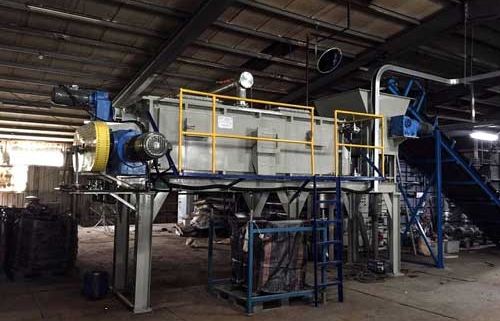First, introduction
As the urban sewage treatment rate increases year by year, sludge production also increases dramatically. According to the “Environmental Statistics Annual Report 2010” of the Ministry of Environmental Protection, at the end of 2010, there were 2,881 urban sewage treatment plants in China with a designed processing capacity of 123.31 million t/d, and a total of 33.62 million tons of wastewater was treated throughout the year. Based on this calculation, the annual sludge production in Chinese cities is estimated to be nearly 30 million tons (80% water content). Effective reduction and disposal of sludge has become an important task for environmental protection.
Sludge drying is an intermediate link in the final disposal of sludge. After drying, the sludge can obtain low calorific value that reaches the level of self-sustaining combustion, and can reach a certain level of hygiene and harmlessness. Disposition provides conditions.
Second, the blade dryer
The paddle dryer is a horizontal agitating continuous drying device mainly based on heat conduction. It is mainly composed of a jacketed cylinder, a hollow blade shaft and a driving device. It is imported and exported from the rotary joint of the shaft end, and the heating medium is respectively Enter the inner casing of the dryer casing and the inner cavity of the blade shaft, heat the inner wall of the dryer, the hollow blade and the hollow shaft, and dry the material by means of heat conduction. The material continuously enters the dryer, and is continuously turned over under the continuous rotation and stirring of the hollow blade, so that the material can be fully and uniformly heated. The inclined blade conveys the dried material to the discharge port while rotating.
The paddle dryer has the characteristics of low energy consumption, high heat utilization rate, safety and reliability, low equipment occupation and investment, low operation and maintenance cost, self-purification ability and strong regularity of dry particles.
Third, engineering application
A total treatment capacity of 300t / d sludge drying treatment project, covering an area of 2800m <sup> 2 </sup>, drying sludge containing 75% ~ 85% water to 10% ~ 30% water; drying equipment Three paddle dryers are used, each with a processing capacity of 100t/d; the heat source is steam generated by the waste incineration power plant, and the sludge is dried into a waste incineration power plant to achieve sludge decontamination. Targets for reduction, stabilization, and resource utilization. The sludge treated by the project comes from the urban sewage treatment plant. Due to the imperfect rainwater and sewage diversion pipelines in the project service area, the sludge has a large amount of sand and low organic matter content.
(1) Process Description
The sludge drying treatment process of the project mainly includes the following systems: wet sludge storage and transportation system, drying system, dry sludge storage and transportation system, odor processing system, electrical system, automatic control system; wherein the drying system is 3 oars The leaf type sludge drying production line, each blade type sludge drying production line mainly includes one paddle type dryer, one carrier gas washing tower, and one carrier gas circulation fan. The operation of the paddle sludge drying production line is described below.
(1) The sludge entering the dryer is subjected to intense agitation and vibration under the action of the blades, and the heating at the heating interface, the moisture content is quickly evaporated;
(2) Under the action of the circulating fan, the air as the carrier gas flows through the dryer quickly, carrying moisture, ensuring the evaporation rate and diffusion speed of the sludge moisture;
(3) The carrier gas is discharged from the dryer and treated by the washing tower to remove a large amount of water vapor and a small amount of dust contained in the carrier gas;
(4) Most of the treated carrier gas is passed to the dryer for recycling, and the other part enters the deodorization system.
(2) Operation cost analysis
Analysis of resources and energy demand in the operation of the drying process shows that the resource and energy consumption costs are 49,210 yuan / d, and the dry sludge resources and energy consumption cost per ton are 164 yuan.
Fourth, the conclusion
Through the successful application of the paddle dryer in the sludge miniaturization project, it is concluded that it has great technical and economic advantages as a sludge drying technology:
(1) The paddle-type sludge drying process is safe, stable and reliable, and can be minimized, and the pollutant discharge can meet the discharge standard requirements;
(2) Low engineering investment and operating costs, small floor space and low energy consumption;
(3) The management is simple, convenient, and flexible in operation mode. The operation mode and parameters can be adjusted according to the nature and quantity of sludge in different seasons;
(4) Facilitate automatic control of sludge treatment and disposal process and improve management level;
(5) The paddle dryer uses steam as a heat source, which is operated in conjunction with waste incineration power generation equipment. With the concept of circular economy, it can maximize resource conservation and reduce energy consumption.



